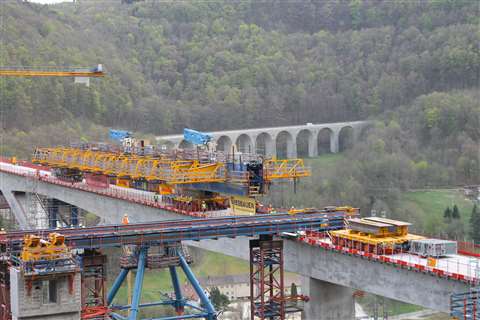Wiesbauer and Krebs on track and on video
09 June 2020

A major rail infrastructure construction project in Germany was helped on its way by transport and lifting specialist Wiesbauer using its new Cometto transporter and Krebs Korrosionsschutz operating its existing equipment.
A video of the operation can be viewed here.
Extending the ICE high speed rail connection between Stuttgart and Ulm is a project full of challenges. A milestone was reached with the erection of the 485 metre-long Filstal Bridge. Its impressive two-line structure stands over the valley near Mühlhausen im Täle. At 85 metres, it is Germany’s third highest railway bridge and the second largest single structure on the new ICE line (Stuttgart’s main railway station will be the largest). When it opens in 2022 Deutsche Bahn’s high speed trains will cross the new bridge in seven seconds at 250 km/h.
Main contractor is the Max Bögl / Porr consortium. The transport element was to move an 85 metre long, 350 tonne formwork carriage on self propelled modular transporter (SPMT). Wiesbauer had already been working on site for months with its mobile cranes when it put in a bid for the transport job. Final preparations for the move continued high above the A8 motorway while the traffic still flowed. Daniel Welsch, Porr construction manager commented, “We illustrated each phase of the transport in advance in our schedule. In doing so, we also determined the forces acting on the Cometto MSPE self-propelled vehicle.”
Working in a valley meant wind had to be considered as a factor in the moving job. Joachim Kolb, Cometto sales manager said, “To guarantee stability in all phases of the transport, calculations were made for wind speeds of 36 km/h, 72 km/h and, in case of a storm, 100 km/h too.”
Towards the end of 2019, in preparation for the job, Wiesbauer ordered 20 axle lines of (48 tonnes per line) SPMT and two 202 kW power pack units from Cometto. Coronavirus notwithstanding, delivery was made in time. “They’re celebrating their baptism of fire here,” said Jochen Wiesbauer.

For the move Wiesbauer used two MSPE 4‑axle units arranged side-by-side, while on the other side, 58 metres away, fellow German transport specialist Krebs Korrosionsschutz used a 6-axle MSPE for the other end.
The calculations resulted in a maximum permissible lateral tilt of 4.58 per cent with a wind speed of 72 km/h. To safely remain within this limit, at short notice due to a weather warning, the move was brought forward by a day. Everything had to be done quickly and precisely to keep to the schedule.
Transport managers Jörg Neuhäusel from Krebs Korrosionsschutz and Leonard Schmid from Wiesbauer laid and programmed the data cable between the power pack units so that the entire vehicle group could be moved using one radio remote control transmitter. They also put a chalk line guide on the bridgefor the transport to follow accurately.
Travelling at 0.5 km/h the 485 metres was covered from the Ulm side of the bridge over towards Stuttgart. During the transport Neuhäusel kept an eye on the transverse tilt. “At no time was 1.5 % exceeded – all safe.”
Before reaching the final position the consortium had installed a cross-transfer track. At a later date it will be used to shift the formwork carriage into the position of the second bridge axis. The first beam of this track now had to be overcome by the transport.
To do that, a second Cometto SPMT combination with two 6-axle bogies was placed ready, also in a side-by-side arrangement. The two 4-axle bogies then handed the load over the first cross-transfer track to the two 6-axle units. The distance between the supports then increased to 71.90 metres with a total weight – load and vehicles – at 438 tonnes.
See the video of the operation here.




